February was slightly warmer and wetter than average across Illinois, bringing an end to a very warm climatological winter season. The preliminary statewide average February temperature was 31.2 degrees, 0.30 degrees above the 30-year normal and tied for 42nd warmest on record. Preliminary statewide average total precipitation for February was 2.13 inches, 0.07 inches wetter than the 30-year normal and tied for 46th wettest on record.
Data are provisional and may change slightly over time
Mostly Warm, Briefly Cold in February
The first two months of the climatological winter season were much warmer than average, with very few cold air incursions. As the temperature plot from Bloomington shows (below), February started consistently warmer than average, but multiple cold air incursions in the latter half of the month led to an overall near-normal temperature month.
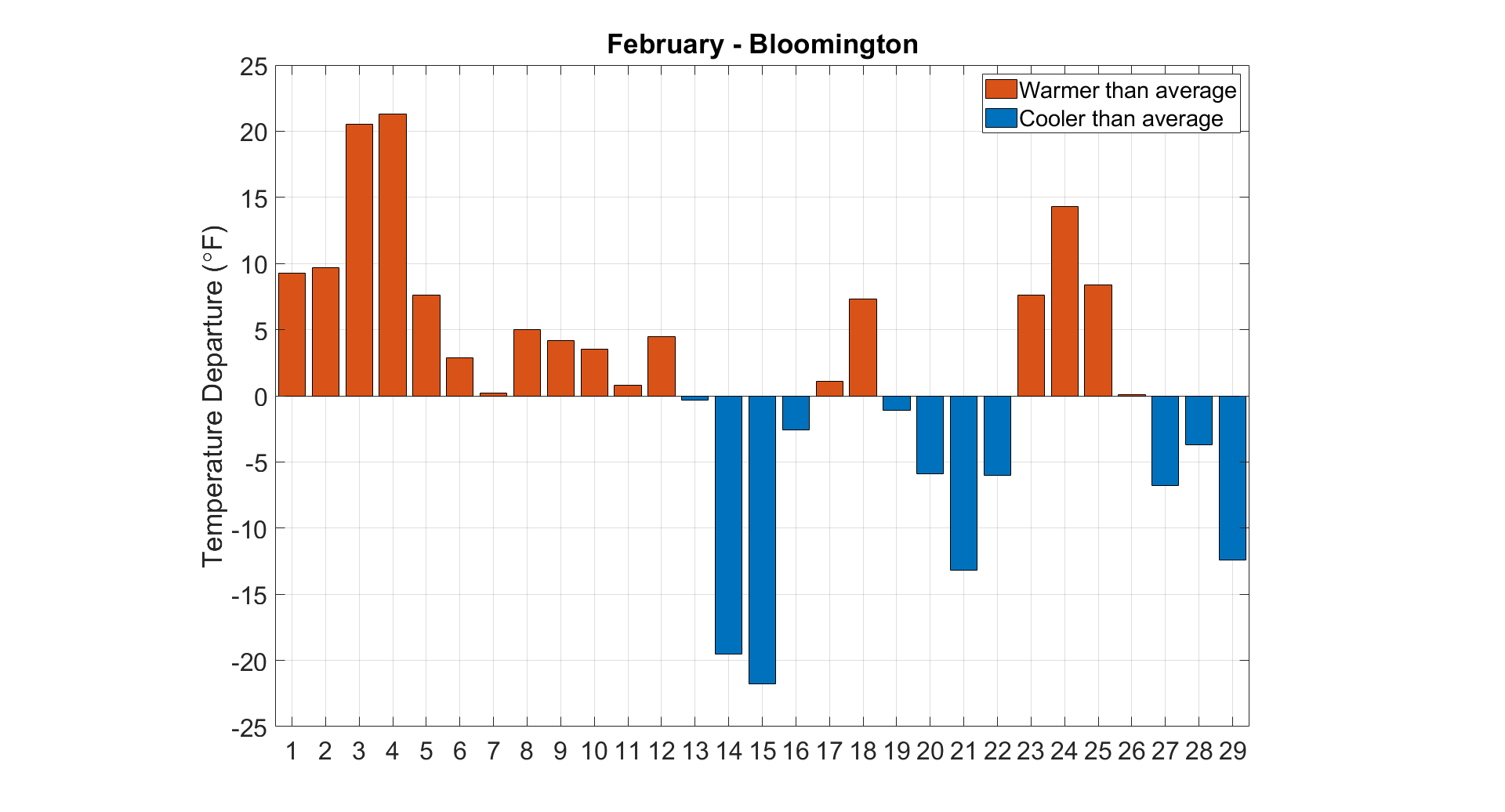
Average temperatures in February ranged from the high teens in northwestern Illinois to the high 30s in southern Illinois. Average temperatures ranged within a degree of the long-term average for all but a southeast sliver of the state. The statewide average February temperature was 31.2 degrees, which is 0.30 degrees above the 30-year normal and tied for 42nd warmest on record.
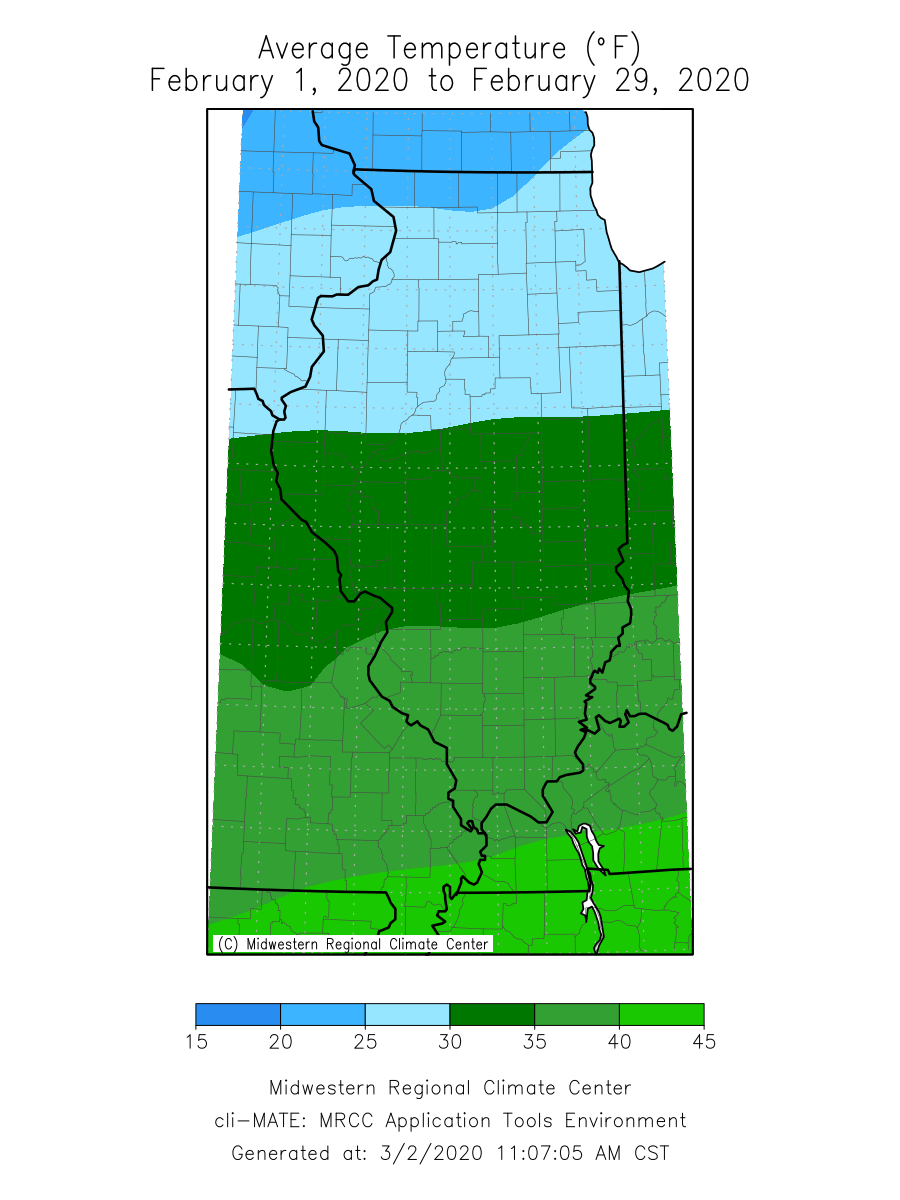
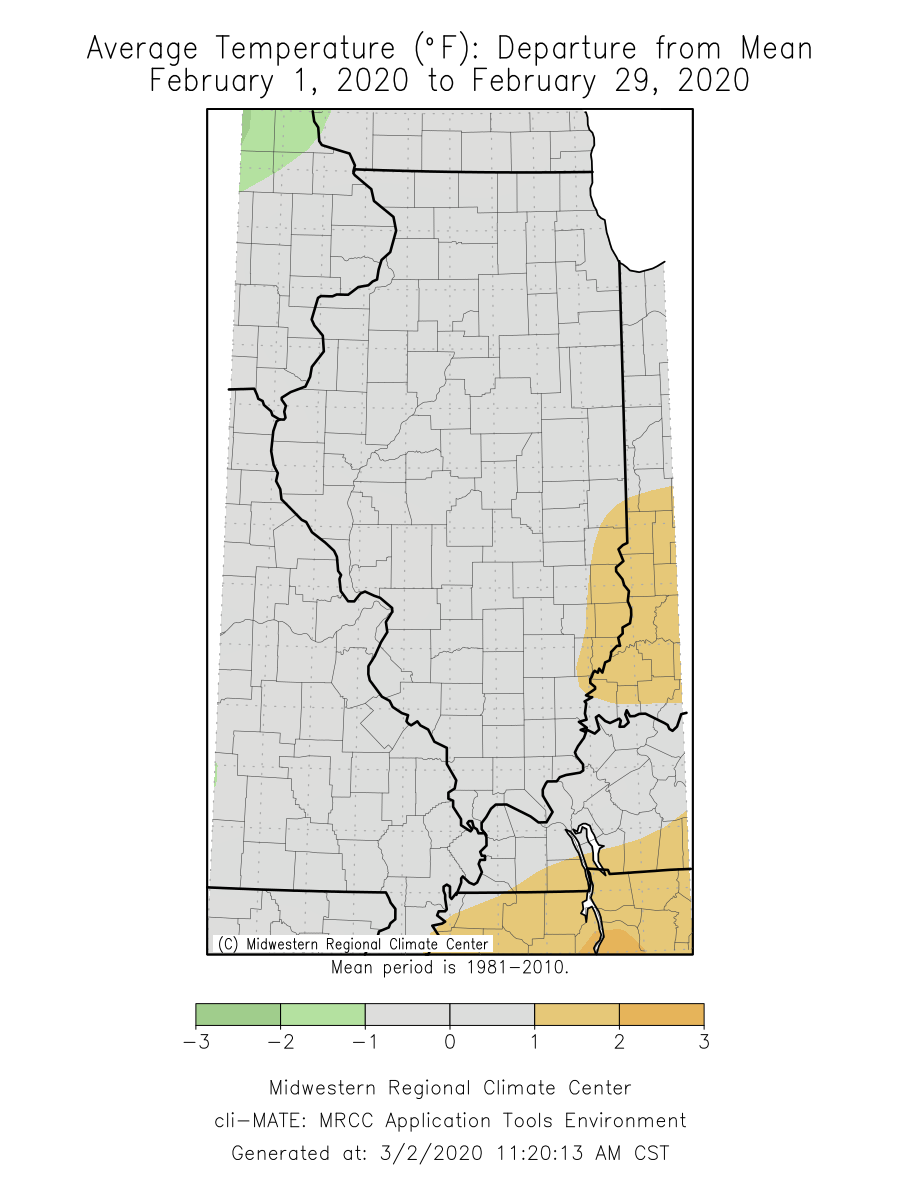
The warm weather that started the month resulted in 115 daily high maximum temperature records and 12 daily high minimum records being broken across the state. One truly incredible departure was a 70 degree high temperature in Charleston in Coles County on Feb. 3. This was nearly twice the long-term average daily high temperature of 38 degrees for that calendar day in Charleston and 5 degrees above the previous record. Eleven days later the Charleston station broke its daily low maximum temperature, reaching only 15 degrees on Valentine’s Day. In total, cold air incursions in February resulted in 23 daily low maximum temperature records and 34 daily low minimum temperature records being broken, most of which were recorded on Valentine’s Day.
The highest temperature recorded in the state in February was 72 degrees in Effingham County, while the lowest temperature was -18 degrees in Jo Daviess County.
An End to a Very Warm Winter Season
February brought an end to climatological winter, which will be best known for persistently warmer than average weather. The preliminary December to February statewide average temperature was 32.6 degrees, which would result in this being the 12th warmest climatological winter season on record in Illinois.
This winter season’s mildness is characterized well by the Accumulated Winter Season Severity Index (AWSSI), which uses daily accumulation of points, based largely on temperature, to characterize winter season severity. The map below shows accumulated winter season severity as of March 3 for individual stations across the U.S. All stations in Illinois have so far exhibited a mild or moderate winter season (i.e., below average severity). AWSSI data and maps are created by the Midwestern Regional Climate Center (https://mrcc.illinois.edu/research/awssi/indexAwssi.jsp).
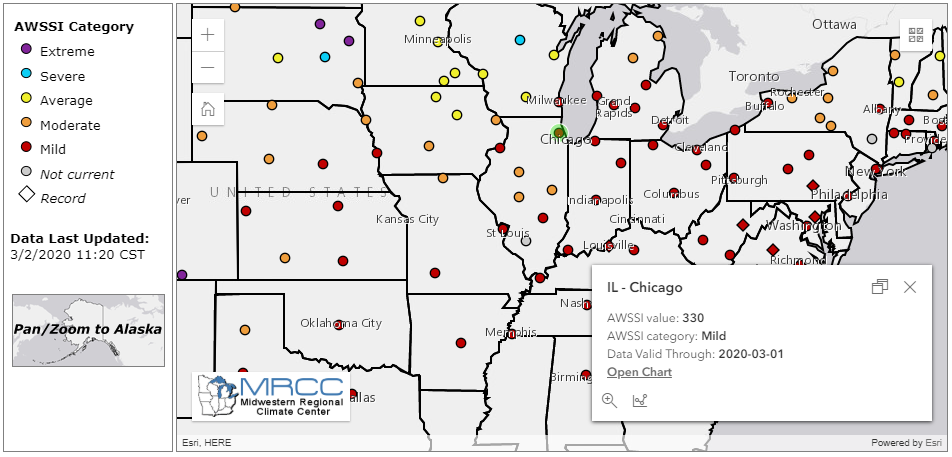
Wet South, Dry North
Winter precipitation depends strongly on the location of the subpolar jet stream, which often characterizes the track for winter storms. Last month storms tended to track south of the state, bringing the most rain to southern and south-central portions of Illinois. Total February precipitation ranged from over 10 inches in far southern Illinois to just over a tenth of an inch in northwestern Illinois. These totals range from over 150 percent of average February precipitation in southern Illinois to less than 25 percent of average in northern Illinois.
This was the driest February on record at Gladstone Dam in Henderson County, with only 0.04 inches of precipitation recorded, despite the extra February day this leap year. The wettest place in the state last month was Cairo in Alexander County, with 7.34 inches total precipitation.
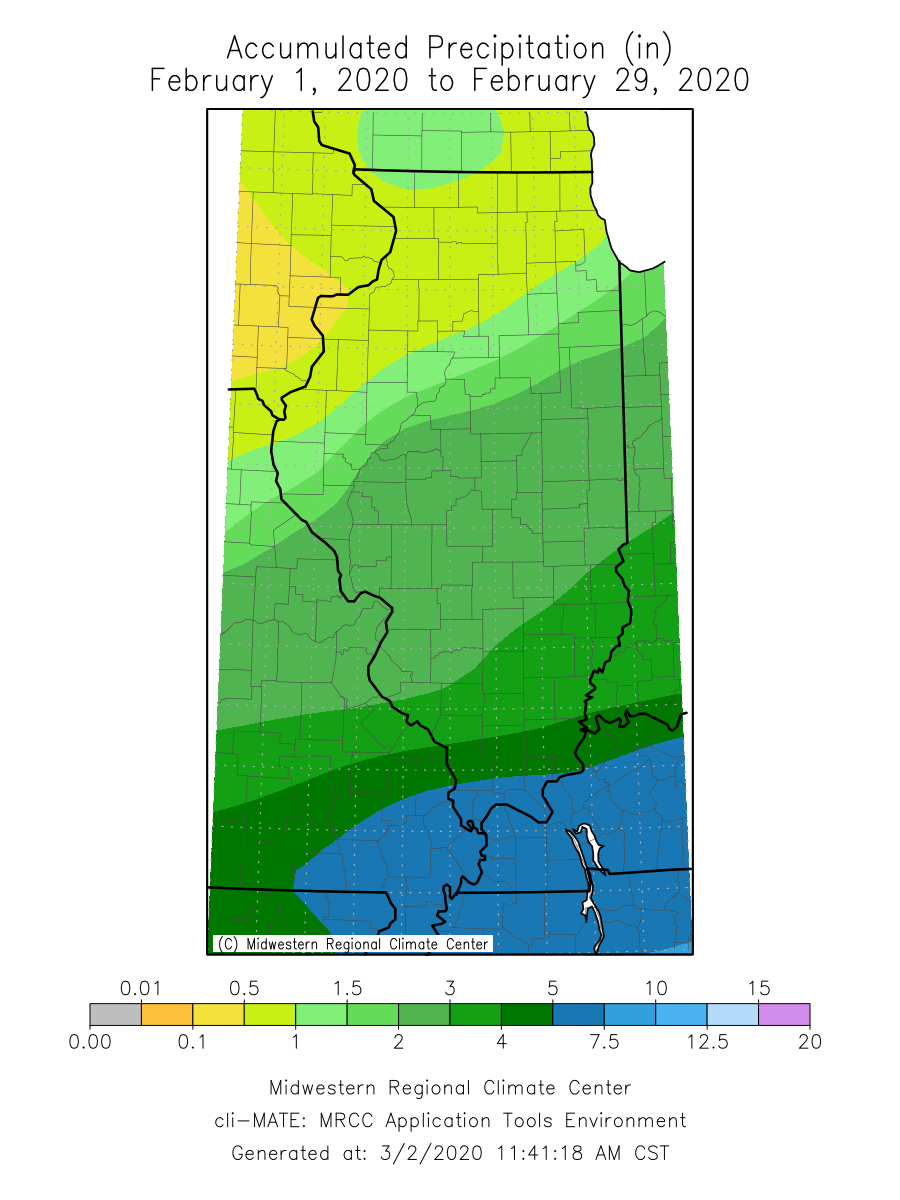
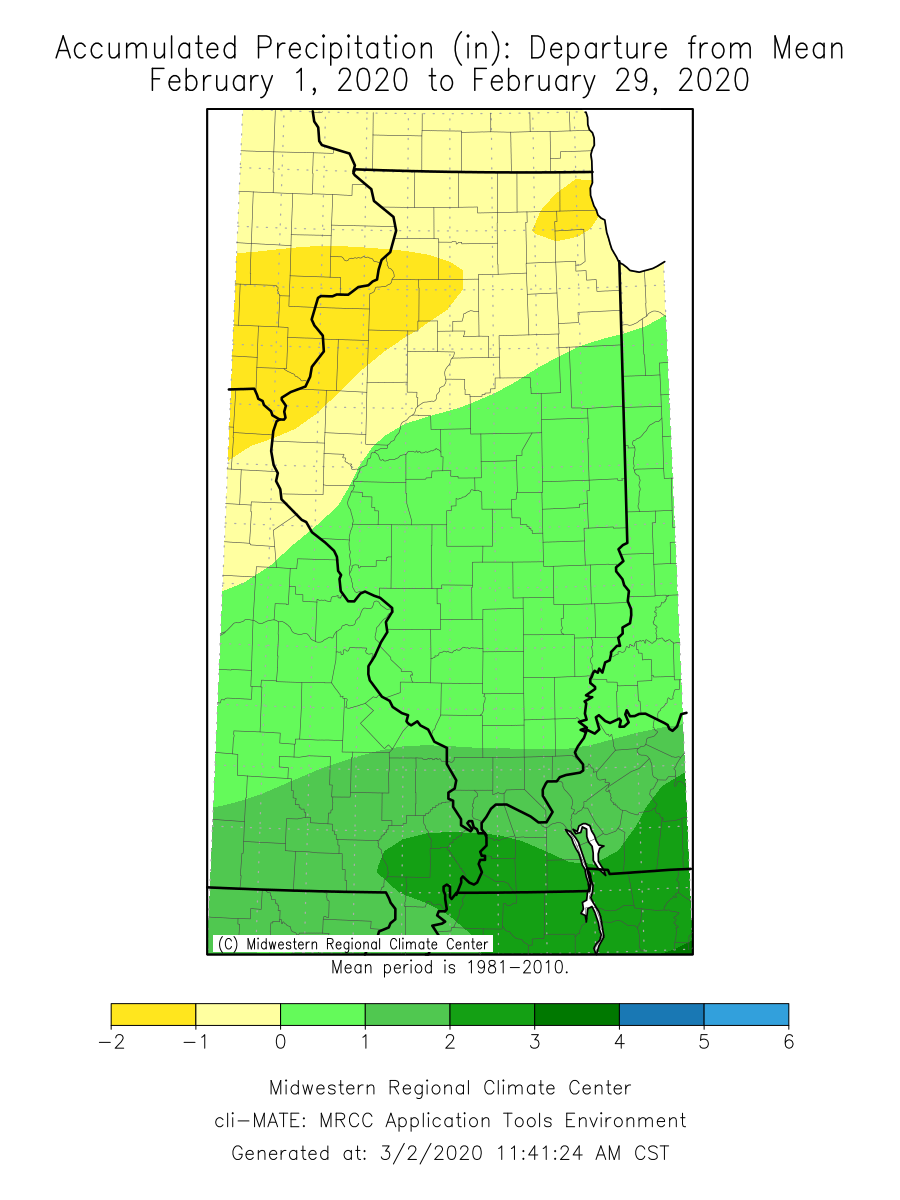
Overall the preliminary statewide average total February precipitation was 2.13 inches, 0.07 inches wetter than the 30-year normal and tied for 46th wettest on record. As a point of reference, the statewide total precipitation for February 2019 was 3.21 inches and for February 2018 it was 4.88 inches.
While southern Illinois was experiencing persistent rain, most of northern Illinois was treated to abundant snowfall in February. Snowfall totals from last month ranged from just over 15 inches in Kane County to less than an inch along Interstate 70. Thanks to a mid-month storm, a small area of Mason, Cass, and Menard counties received 6 to 8 inches more than average snowfall in February, whereas most of the rest of the state north of Interstate 70 received near average to just a couple of inches above average snowfall last month.
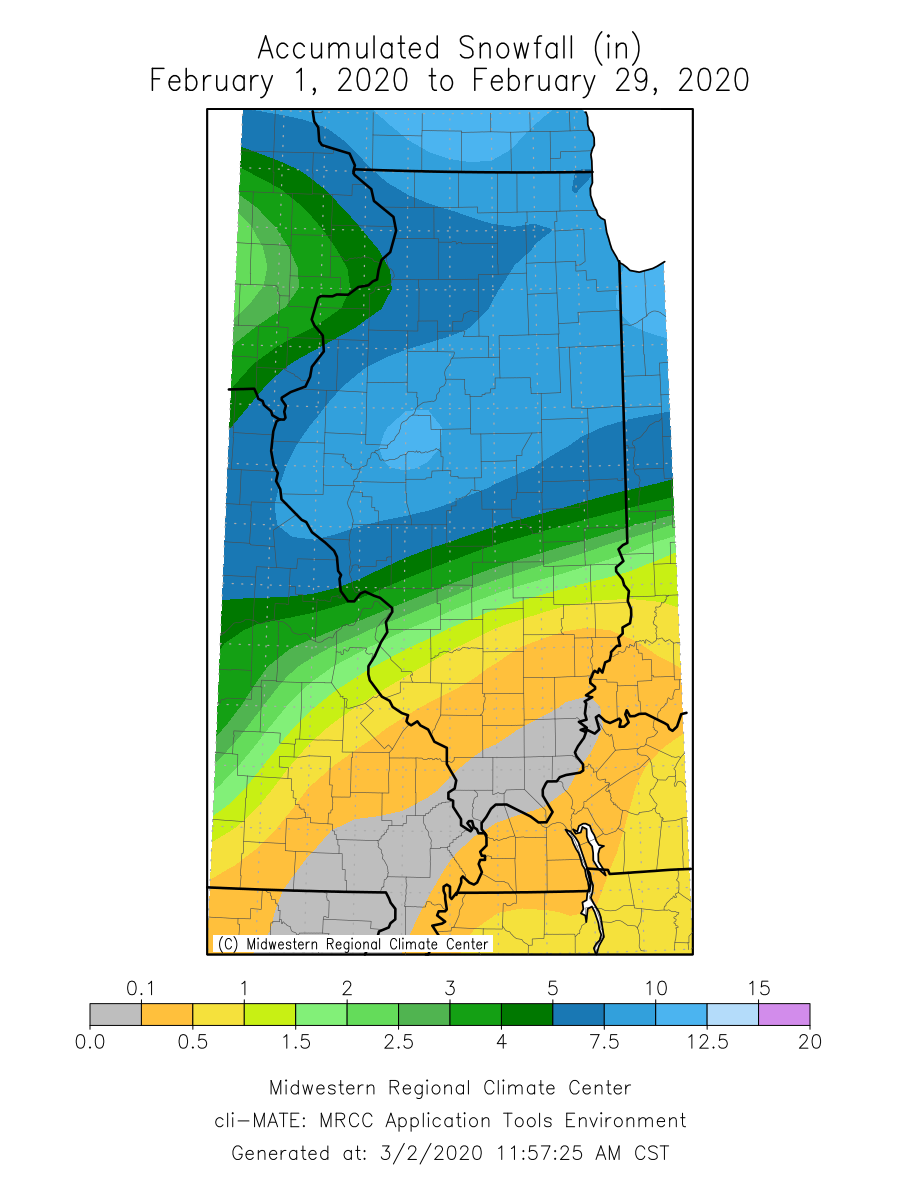
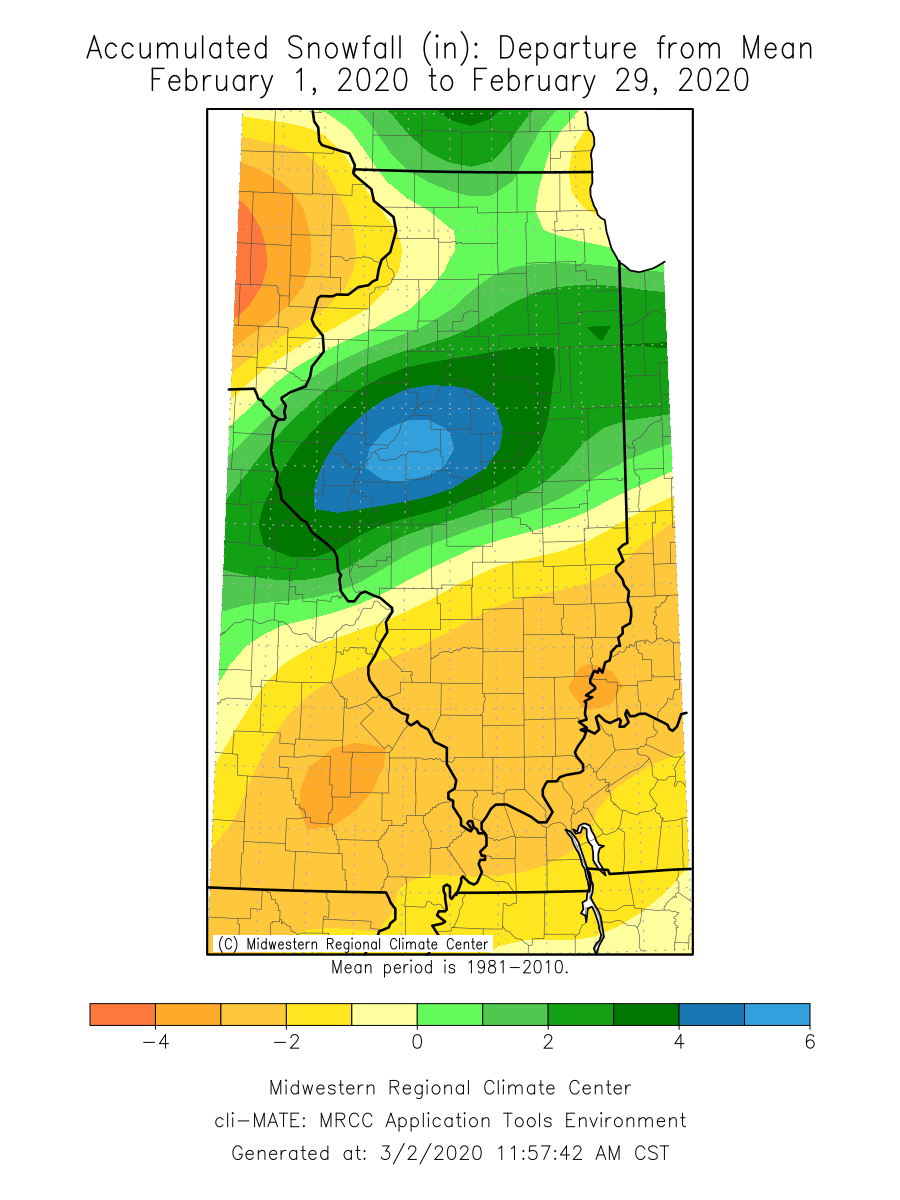
Snowfall totals over the climatological winter season (December–February) are within 5 inches of the long-term average for most of the central and western portions of the state, while a snowfall deficit exists along the Indiana border and for most of southern Illinois. The largest departures from average are in the Chicagoland area, where winter season snowfall has been 15 to 20 inches less than average.
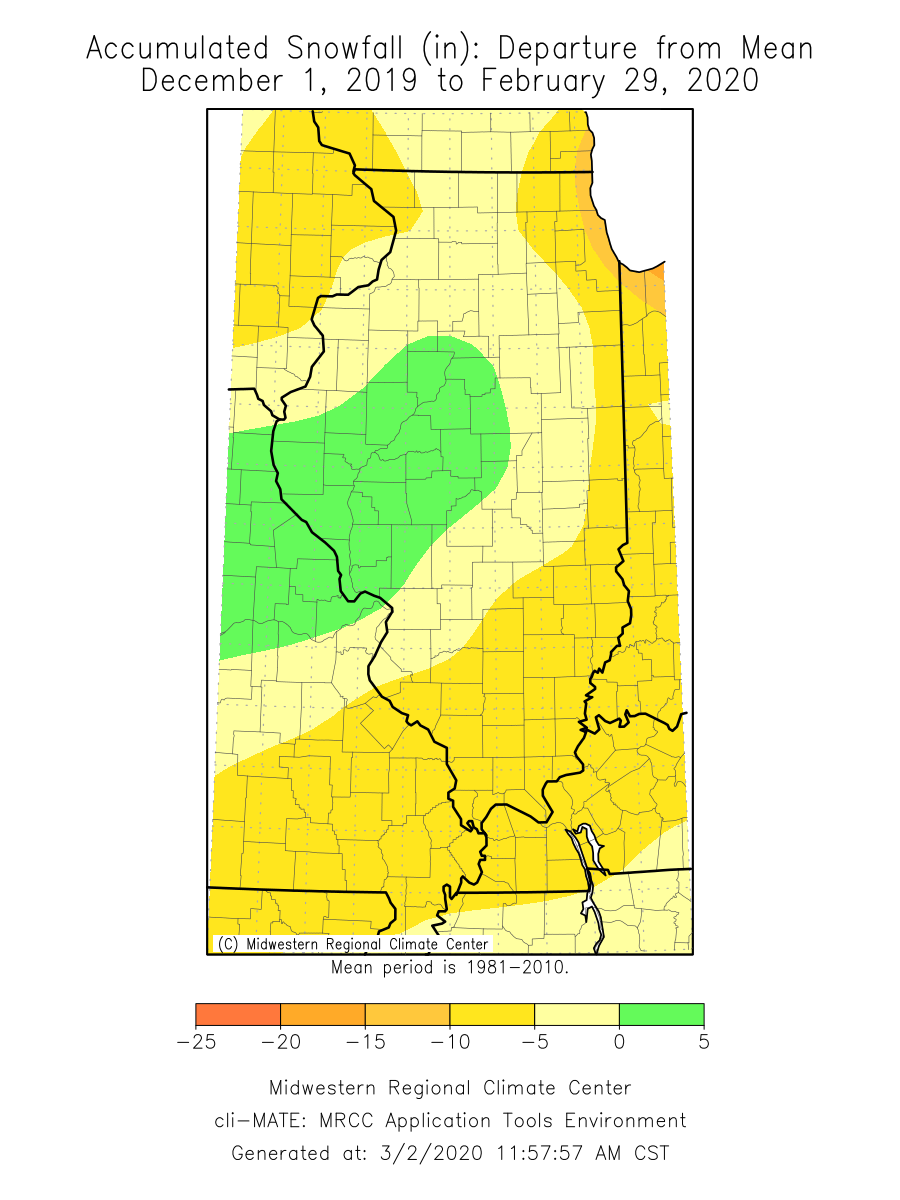
Outlooks
Short-term 8- to 14-day outlooks from the NOAA Climate Prediction Center show strongly elevated odds of both above normal precipitation and above normal temperatures across the state.
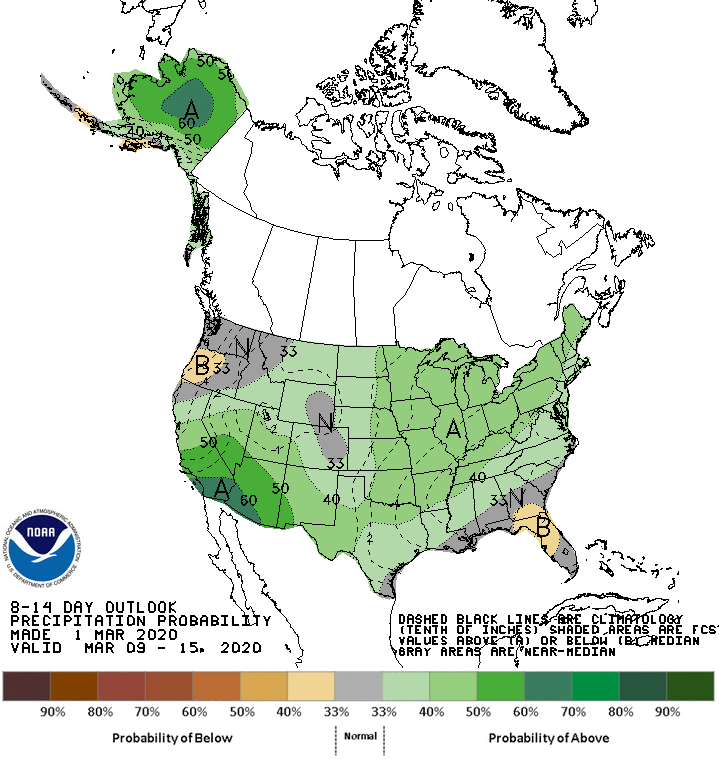
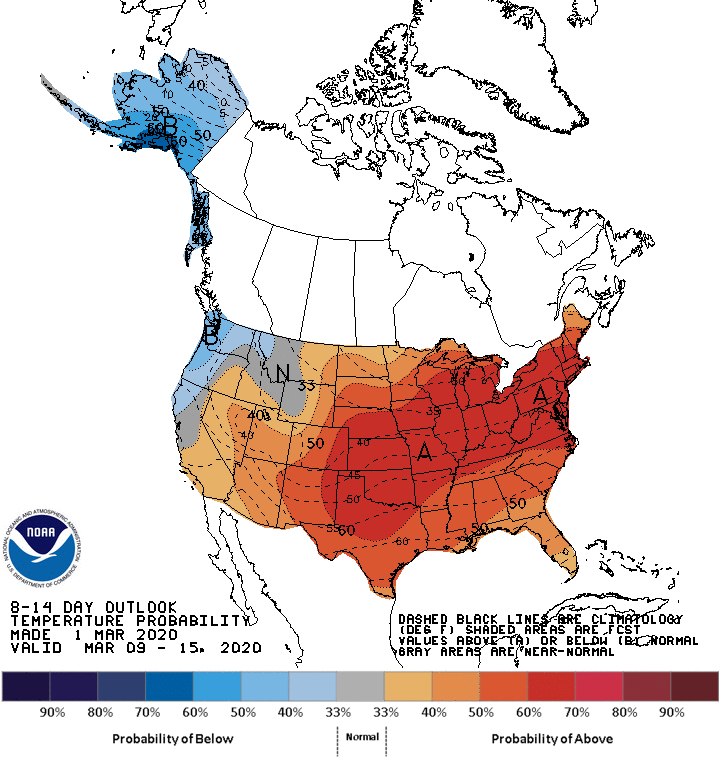
Longer-term 30-day outlooks show probabilities remain elevated for warmer than normal conditions across the state for the remainder of March, while elevated probabilities of wetter a wetter than normal March persist in the southern half of the state.


Spring flooding outlooks from the National Weather Service continue to show above normal to much above normal risks of flooding in the Mississippi River Basin, including 473 gauges with a 50 percent or greater chance of flooding between March and May (see below). Most gauges along the Mississippi River in Illinois have a 50 percent or greater chance of major flooding this spring, with gauges along the Illinois, Kaskaskia, Wabash, and lower Ohio rivers having a similar chance of minor to moderate flooding before May.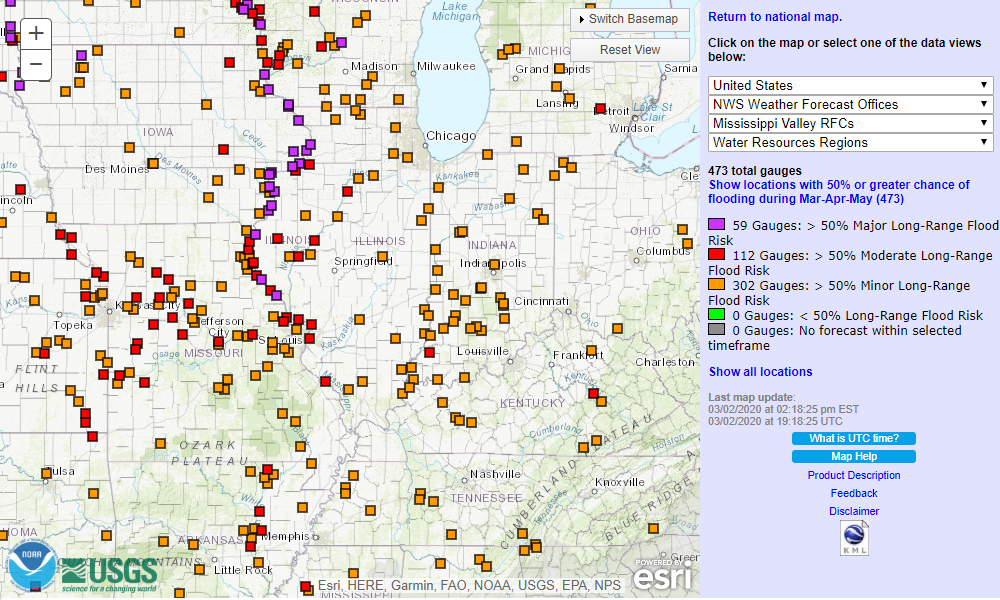
The elevated flood risk is due to: (1) very wet soils across the entire region; (2) large snowpack in the Upper Midwest; and (3) outlooks for a wetter than normal climatological spring season. For those wanting more information related to current hydrologic conditions and/or spring flood outlooks, I have included links to relevant partners and information below.
National Weather Service River Forecast Center: https://www.weather.gov/ncrfc/
NOAA Climate Prediction Center Soil Moisture: https://www.cpc.ncep.noaa.gov/products/Soilmst_Monitoring/US/Soilmst/Soilmst.shtml
NOAA Climate Prediction Center Seasonal Outlooks: https://www.cpc.ncep.noaa.gov/products/predictions/90day/

